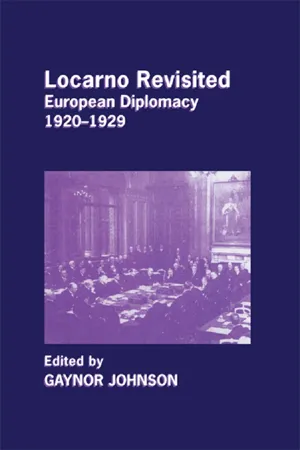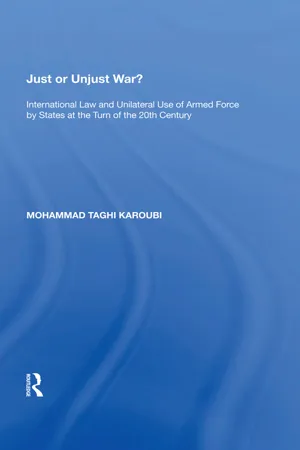History
Kellogg-Briand Pact
The Kellogg-Briand Pact, signed in 1928, was an international agreement between 62 countries to renounce war as a means of settling disputes. It was an attempt to prevent another world war and promote peace through diplomacy and arbitration. However, it ultimately failed to prevent the outbreak of World War II.
Written by Perlego with AI-assistance
Related key terms
2 Key excerpts on "Kellogg-Briand Pact"
- eBook - ePub
Locarno Revisited
European Diplomacy 1920-1929
- Gaynor Johnson(Author)
- 2004(Publication Date)
- Routledge(Publisher)
4McKercher suggests that Chamberlain's involvement in the negotiation of the Kellogg-Briand Pact provides an example of a faltering rather than confident approach to diplomacy. Chamberlain is consigned to a peripheral role but the reason for this is not fully explained.5 Grayson's discussion of the subject is very brief. In defending Chamberlain's handling of European diplomacy, he devotes one paragraph to a discussion of the pact. Such dismissive treatment suggests that he too found little to praise in Chamberlain's actions. At the root of McKercher's argument is scepticism about Chamberlain's ability to understand the dynamics of US foreign policy. The Foreign Secretary had appeared ill-prepared at the Three Power Naval Conference in the summer of 1927, which had extended the provisions made at the Washington Naval Conference of 1921–22.6 Why then should Chamberlain have any greater understanding of the diplomacy behind a pact to outlaw war? David Dutton argues that Chamberlain was not enthusiastic about becoming involved in the negotiations of the Kellogg-Briand Pact and preferred to adopt a cautious approach. 7 This is not an entirely fair assessment. Such observations make little reference to the nature of the relationship between the Locarno powers after 1925 and the bearing that the Locarno powers' relationship with the United States had on the negotiations.8 These issues were very close to Chamberlain's heart.9 - eBook - ePub
Just or Unjust War?
International Law and Unilateral Use of Armed Force by States at the Turn of the 20th Century
- Mohammad Taghi Karoubi(Author)
- 2017(Publication Date)
- Routledge(Publisher)
supra note 13, pp. 227–228.51 Ibid .52 Ibid., p. 228.53 Ibid.54 Ibid.55 Ibid.56 Ibid.57 Ibid.58 Kellogg – Briand Pact, 27 August 1928, in force 1929, 94 LNTS 57.59 See J. Brierly, ‘Some Implications of the Pact of Paris’, 10 BYIL 1929, p. 208. See also Brownlie, supra note 13; Q. Wright, ‘The Meaning of the Pact of Paris’, 27 AJIL 1933; J. Moor, ‘Development of the International Law of Conflict Management’, 47 NSL edited by J. Moor, F. Tipson, and R. Turner, 1990.60 See Bowman and Harris (eds.), Multilateral Treaties , Index, 1984, pp. 75–76.61 For an account of the diplomatic background of the Pact see Kellogg, ‘The War Prevention Policy of the U.S.A.’, 22 AJIL 1928, p. 253.62 Brownlie, supra note 13, p. 83.63 Ibid., See also Dissenting of Judge Pact in the Trial of War Criminals in the Far East , 1965, p.37.64 Ibid., p. 83. See also Q. Wright, supra note 59.65 See Q. Wright, supra note 59, p. 39.66 Ibid., p. 27.67 See H. Miller, supra note 19, p. 95.68 Ibid.69 Some writers argued that this interpretation could be supported by the controversy created by the reply of the Committee of jurists in the aftermath of the Corfu Channel Case with regard to the effect of the League Covenant on the use of force short of war.70 See I. Brownlie, supra note 13, p. 85.71 See L. Oppenheim, International Law , (7th edn), edited by H. by Lauterpacht, Longmans, London, 1952, p. 184. L. Oppenheim, International Law , (8™ edn), edited by H. Lauterpacht, Longmans, London, 1995.72 Ibid.73 See I. Brownlie, supra note 13, p. 86.74 Ibid., pp. 85–88.75 Cited in Ibid., p. 88.76 Ibid.77 Following the Sino-Japanese conflict in Manchuria in 1931, the Acting President of the Council of the League stated the responsibility of members of the League not to seek redress for grievances against another State except by pacific means, which was reaffirmed in the Pact. See I. Brownlie, supra note 13, p. 114. The League Assembly also, when considering the crisis and its resolution of 11 March 1932 referred to, ‘… undertaking entered into by members of the League of Nations to respect and preserve as external aggression the territorial integrity and existing political independence of all members of the League; … their obligation to submit any dispute which may arise between them to procedures for peaceful settlement… in full harmony with the Pact… which is one of the cornerstones of the peace organisation of the world’. League of Nations Supplement,
Learn about this page
Index pages curate the most relevant extracts from our library of academic textbooks. They’ve been created using an in-house natural language model (NLM), each adding context and meaning to key research topics.

